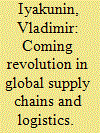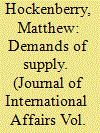|
|
|
Sort Order |
|
|
|
Items / Page
|
|
|
|
|
|
|
| Srl | Item |
| 1 |
ID:
107173


|
|
|
| 2 |
ID:
117964


|
|
|
|
|
| Publication |
2012.
|
| Summary/Abstract |
Global trade can give rise to new economic possibilities in developing regions and open a boundless world of opportunity for design and production. The above map shows the supply chains behind electronics manufacture. Constructed by bringing together the routes of consumer electronics products at different stages of assembly, this map provides an overview of the network traveled in global manufacture. As production has become increasingly complex, actors have emerged to take advantage of friction inherent in supply lines. Each point and pathway shown on the map is a site for the potential proliferation of transnational conflict. The products we consume traverse convoluted
pathways of production; pathways put at risk by questionable practices that bring profits at the expense of working conditions, regional stability, and the environment. As seen in this supply chain, the smooth shells that characterize electronic objects can also be cracked by the jagged realities entailed in their construction.
|
|
|
|
|
|
|
|
|
|
|
|
|
|
|
|
| 3 |
ID:
142234


|
|
|
|
|
| Summary/Abstract |
While the importance and key features of transnational benchmarking have received increased attention in recent years, the organisational contexts of this benchmarking have not yet been analysed systematically enough. Drawing on actor-network theory, this article identifies two key aspects of these contexts. The first is embeddedness, which refers to the degree to which there are networks that carry information and action from the benchmark to its contexts and back that are sustained institutionally, including by technical artefacts, objects, and routine local practices. Embeddedness is critical to the effectiveness of benchmarking. The second is publicness, which refers to the degree to which these networks exhibit expanding flows of information across widening circles of engagement, or instead are marked by control, domination, and exclusion. The article argues that benchmarking as a form of governance has an inherent impetus toward greater publicness, although this can be prevented by self-interested actors or problems associated with embeddedness. The article then explores the relevance of these conceptual points by examining cases of transnational benchmarking: disaster risk reduction and supply chain management.
|
|
|
|
|
|
|
|
|
|
|
|
|
|
|
|
| 4 |
ID:
162892


|
|
|
|
|
| Summary/Abstract |
As the world is smoothing the transition towards a low-carbon energy structure, natural gas has occupied a critical position in global energy supply. Also, globalization has catalyzed ever-increasing indirect energy flows in international trade. In order to present a comprehensive overview of natural gas use in globalized economy, this paper applies the systems multi-regional input-output (MRIO) analysis to track natural gas use from primary suppliers to final consumers via the links by producers in the world economy, supported by typical statistics for the year of 2011. Natural gas embodied in international trade is revealed amounting to 2722.1 bcm, in magnitude up to 90% of total gas extraction for energy use, indicating the intensive relocation of gas use by trade. 83% of traded embodied natural gas is associated with intermediate trade, mainly from leading primary suppliers, including Russia, USA and Western Asia, to dominant final consumers, like USA, EU27 and East Asia. Significant differences are found between direct and embodied natural gas flows. Consumption-based resource efficiency can break the illusion of efficiency improvements, and trade imbalance in terms of gas use can be opposite to the trade imbalance in conventional monetary terms. This paper has constructed a comprehensive analytical framework to trace natural gas flows in globalized economy for the first time, aiming to provide new insights for policy making.
|
|
|
|
|
|
|
|
|
|
|
|
|
|
|
|
| 5 |
ID:
145083


|
|
|
|
|
| Summary/Abstract |
We argue that economic links, such as supply chains, can create a common roof that protects foreign investors in host countries that lack strong institutions to protect property rights. Supply chains link the activities of firms: when a host government breaks a contract with one firm, other firms in the supply chain are harmed. These partner firms therefore have incentive to protect one another’s property rights. This leads to the key implication of our argument: host governments are less likely to violate the property rights of firms that are more tightly linked with other firms in the host economy. We test our argument with cross-national data on investment arbitration, a survey of US multinational subsidiaries in Russia, and case studies from Azerbaijan. Our findings imply that one benefit of outsourcing in developing and transition economies is the creation of a network of partner firms that protect each other’s property rights.
|
|
|
|
|
|
|
|
|
|
|
|
|
|
|
|
| 6 |
ID:
182934


|
|
|
|
|
| Summary/Abstract |
Intermodal shipping containers, standardized and capable of being carried on trucks, trains, barges, or ships, have transformed the global economy since they were introduced in 1959. By allowing previously separated segments of regional and global transport systems to interact, they have vastly expanded global trade and facilitated supply chains that stretch around the world. But vulnerabilities in the system became apparent during the COVID-19 pandemic. Problems at key bottlenecks in the system, compounded by an unexpected six-day shutdown of the vital Suez Canal, precipitated global disruptions leading to shortages of goods and soaring prices around the world. As the global shipping industry recovers, it will have an opportunity to transition toward a system that is more resilient.
|
|
|
|
|
|
|
|
|
|
|
|
|
|
|
|
|
|
|
|
|